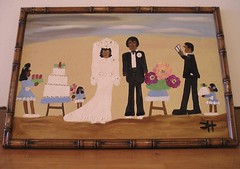Clementine Hunter (December 4, 1886/1887 – January 1, 1988) was born around 1886 at Hidden Hill plantation, near Cloutierville, Louisiana, says Wikipedia.
Clementine’s first husband, Charlie Dupree, died in 1914 and she married Emmanuel Hunter in 1924. The two worked at Melrose Plantation in Northwest Louisiana for many years.
Melrose Plantation, under the guidance of Cammie Henry, became a Mecca for the arts and numerous artists and writers routinely visited. Noted New Orleans artist Alberta Kinsey left some discarded tubes of paints after a visit in 1939 and Clementine used these discarded paints to “mark a picture,” thus beginning her career. Hunter gained support from numerous people associated with Melrose Plantation including François Mignon and James Register.
She was the first African American artist to have a solo exhibit at the Delgado Museum (now the New Orleans Museum of Art) and achieved a significant amount of success during her lifetime, including an invitation to the White House by President Jimmy Carter, and an honorary doctorate bestowed by Northwestern State University. Hunter died on January 1, 1988.
Hunter has become one of the best known self-taught artists, often referred to as the Black Grandma Moses. She is generally credited as being a social historian capturing portrayals of various scenes of a dying plantation life, including picking cotton, gathering pecans, washing clothes, baptisms and funeral scenes. Hunter was noted for painting on any materials, particularly discarded items such as window shades, cardboard boxes, jugs, bottles, and gourds. Her paintings rarely run larger than 18 by 24 inches and her work has generally been considered uneven, with her work from the 1940s to 1960 considered to be the best.
It is very hard for historians to sort myth from fact in the stories and legends that surround her life. Though she became a hugely respected artist and is today considered a folk art legend, Hunter spent her entire life in (or near) poverty. It is said that she never truly grasped the worth of her own artwork, and would often sell paintings from her later-life for a few hundred dollars.
Subscribe to:
Post Comments (Atom)





No comments:
Post a Comment